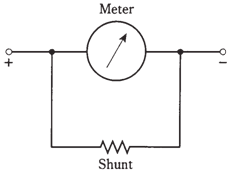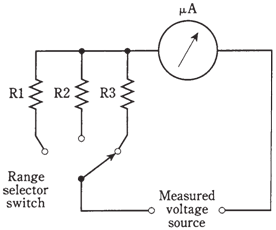Voltmeters
Current is a flow of charge carriers. Voltage, or electromotive force (EMF), or potential difference, is the "pressure" which makes a current possible. Given a circuit the resistance of which is constant, the current which will flow in the circuit is proportional to the voltage placed across it.

Figure: A resistor can be connected across a meter to reduce the sensitivity.
If you connect an ammeter across a source of voltage-a battery, the meter needle will deflect. Actually the milliammeter needle will be probably "pinned" if you do this to it, and a microammeter might well be wrecked by force of the needle striking the pin at the top of scale. For this very reason, you should never connect milli ammeters or micro ammeters across voltage sources. An ammeter, having a range of 0-10A, might not deflect to full scale if it is placed across a battery, but it is a bad idea to do this, as it will quickly drain the battery. Some batteries, like automotive lead-acid cells, can even explode under these conditions. This is because all the ammeters posses low internal resistance. They are designed like that. They are meant to be connected in series with the other parts of circuit, not across power supply.
But if we place a large resistor in series along with the ammeter, and then connect the ammeter across a battery or other type of power supply, you have a short circuit no longer. The ammeter will give an indication which is directly proportional to voltage of the supply. Using the microammeter and a large value of resistor in series, a voltmeter is devised which will draw a little current from the source.
A voltmeter is made to have different ranges for full-scale reading, by switching different values of resistance in the series along with the microammeter. The internal resistance of the meter is large as the values of the resistors are large. Greater the supply voltage, larger the internal resistance of meter, because the required series resistance increases as voltage increases.
It is good when a voltmeter posses a high internal resistance. The reason for this is that you do not want the meter to draw current from the power source. This current should go towards working circuit is hooked up to the supply, and not into getting a reading of the voltage. Also, you might not want, or require, to have the voltmeter connected constantly in the circuit; you might require the voltmeter for testing several different circuits. You do not want the behavior of the circuit to be affected the time you connect the voltmeter to supply. The less current voltmeter draws, the less it will affect the behavior of anything which is working from the power supply.

Figure--Circuit for using a microammeter to measure voltage.
The other kind of voltmeter uses the effect of electrostatic deflection, instead of electromagnetic deflection. You remember that electric fields produce forces, as do magnetic fields. Thus, a pair of plates will repel or attract each other if they are altered. The electrostatic voltmeter using this effect, takes advantage of attractive force between 2 plates having opposite electric charge,. Figure given is a simplified drawing of mechanics of an electrostatic voltmeter.
The electrostatic meter takes no current from power supply. The only thing between the plates is air, and air is a perfect insulator. The electrostatic meter will indicate alternating current as well as direct current. The construction tends to be delicate, and mechanical vibration influences the reading.